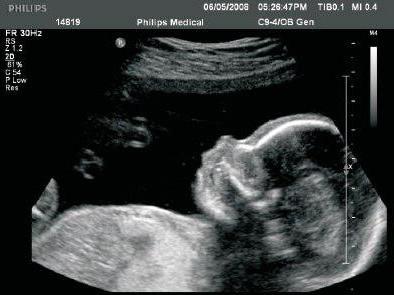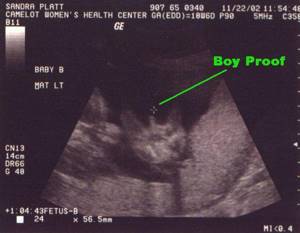Can an ultrasound be mistaken about the sex of a child? This topic worries many parents. Especially those who want to quickly find out who will be born. Depending on the gender of the baby, you will have to buy certain things, come up with a name, choose toys, and so on. And in general, almost every parent is interested in the gender of their unborn baby. This phenomenon is caused not only by idle interest, but also by the desire to have someone specific. For example, a boy and a girl. Having given birth to a guy, I want to quickly understand whether the parents got a baby for the second time. Therefore, many people try to find out the sex of the child during an ultrasound. Could the data reported be false?
Before and now
Previously, the gender of the child was not determined accurately at all. The thing is that ultrasound was invented not so long ago. Therefore, people, as a rule, tried to rely either on folk signs or on personal intuition. Of course, quite often problems arose with such methods of determining gender. There are a lot of mistakes. After all, omens are something like playing roulette. The chances of guessing were divided 50/50.
But the advent of ultrasound somewhat changed the picture of everything that was happening. You won’t be able to decide on your own who will appear. Only a doctor can make a final conclusion. Can an ultrasound be mistaken about the sex of a child? Or should parents believe 100% in what is said? Understanding this issue is actually not as difficult as it seems.
From the deadline
Many doctors say that the answer to this topic will depend on the stage of pregnancy. Throughout the 9 months from the moment of conception, the child and his body develop. This process does not stop. This means that the longer the pregnancy, the higher the likelihood of accurately determining the sex of the child.
Now it is impossible to answer the question posed at the very first ultrasound. After all, as a rule, the study is carried out at 4-6 weeks. At this point, only the fertilized egg, which is attached to the uterus, can be seen in the picture. And listen to the heart. But even during such a period, some doctors try to please parents. Can an ultrasound be mistaken about the sex of a baby at 4-6 weeks? Yes. Moreover, at this stage, it is in principle difficult, almost impossible, to predict who will be born.

Return visit
It turns out that at the very beginning of pregnancy, despite the fact that in reality the sex of the child has already been determined, it is impossible to find out. Of course, many clinics offer to reveal the secret of the child’s gender already at 6-7 weeks from conception. But actually doing this is very problematic. There is a high probability of error.
Can an ultrasound be mistaken about the sex of the child during a second visit to the doctor? The next study is scheduled at approximately 12-14 weeks of pregnancy. It's called screening. Serves to determine the general condition of the fetus and identify certain diseases. For example, Down syndrome. Consists of blood tests and ultrasound.
In this situation, the likelihood of accurately determining the sex of the baby increases. But it is still difficult to draw conclusions with 100% probability. Can an ultrasound be mistaken about the sex of a child? Yes, this is normal. In general, pregnancy is something that occurs individually for each woman. And for some, doctors can accurately tell the gender of the baby at 12-14 weeks, for others they cannot. This is normal.

Can an ultrasound be mistaken about the sex of a child?
Is ultrasound really the most accurate method for determining the sex of a baby? Unfortunately no. There is also a certain percentage of errors that can occur for various reasons.
The accuracy of ultrasound in determining the sex of a child is quite high: it is approximately 90%. The remaining 10% of errors can occur for various reasons. Let's find out how accurately ultrasound determines the sex of the baby and whether it is possible to influence the reliability of the diagnosis, taking into account various factors.
Can an ultrasound confuse the sex of a baby?
Is it possible to confuse the sex of a child with an ultrasound? Of course yes, and there are several reasons for this. Let's find out why ultrasound is wrong about the sex of the child:
- The gestation period is too short. Despite the fact that the first ultrasound is recommended to be performed in the first trimester of pregnancy, it is impossible to determine the sex of the baby at this stage. During this period, the doctor identifies the estimated period of conception and looks at how the embryo develops. The fetus in the first trimester is quite small, and its genitals are not yet formed, so the doctor can easily give out the wrong gender of the child on an ultrasound.
- Insufficient experience of the doctor or poor-quality equipment. The sex of the child can be determined from the 20th to the 25th week of pregnancy. But provided that the diagnostic equipment is in proper condition and the doctor’s qualifications are sufficiently high.
- The child is in an uncomfortable position. In this case, errors in determining the sex of the child are not excluded, but if you undergo a 3D ultrasound, most likely the doctor will be able to recognize who you are having more accurately.
- Late pregnancy. Determining the sex of the baby in the third trimester of pregnancy is quite difficult. Despite the fact that the child is already fully developed at this stage, it is almost impossible to find out his gender. The baby completely occupies the uterus, does not move, and this negatively affects the clarity of the image and distorts it. At this stage, the doctor usually does not reassure parents about the accuracy of the results.
If you go to a well-qualified doctor in a clinic where all the equipment was recently purchased, and your pregnancy is about 20-25 weeks, you can hope for high accuracy of the diagnosis.
If all of the above factors are not observed, the reliability and accuracy of ultrasound, unfortunately, does not always meet the expectations of the expectant mother.
How often does an ultrasound mistake the sex of a child?
Is ultrasound often mistaken about the sex of the child? As we said above, the statistics of ultrasound errors when determining the sex of a child fluctuates within 10%. This is quite a bit, but there is still a possibility that the results will be unreliable.
As you already understand, there are not many errors during ultrasound, and each of them has a specific explanation.
It is worth noting that the minimum percentage of errors is shown by three-dimensional diagnostics. With 3D equipment, a specialist can see much more: in this case, ultrasound in his hands turns into a truly unique tool, which is many times superior to equipment for two-dimensional diagnostics.
Externally, ultrasound machines, both three-dimensional and two-dimensional, look the same. They differ only in being equipped with a special module and special sensors. In addition, the scanning parameters, productivity and frequency of the ultrasonic wave remain the same. The sensor in 3D diagnostics is several times larger in size than the standard one, since inside it there is a two-dimensional sensor that constantly moves and transmits a three-dimensional image to the monitor screen. That is, three-dimensional ultrasound would not have appeared without two-dimensional ultrasound. And even now it cannot exist without a two-dimensional sensor.
According to doctors, a combination of two diagnostic methods will help reduce the percentage of ultrasound errors when determining the sex of a child: 3D and 2D.
In this case, the doctor receives the information he needs in the traditional way, and then supplements it with a three-dimensional image, as a result of which the clearest and most accurate picture emerges in front of him.
So, we found out with what accuracy ultrasound determines the sex of the child. It can be concluded that in comparison with conventional methods, including folk and calendar methods, medical diagnostics is the most effective. If you want to find out the sex of your baby with high reliability, it is better to entrust its determination to experienced diagnosticians!
Rate the material:
thank you, your vote has been accepted
Get to know yourself
Not a car, but a doctor
Can an ultrasound be mistaken about the sex of a child? There is no clear answer to this question. Solving the question of a baby’s gender is a matter of nature. And all the research can only indicate who the future parents will have. And not with 100% probability.
If the parents asked who they will have, the doctor will give the answer. That is, a person. And no machine will determine the gender of the child. Based on the resulting image, it is the doctors who give their conclusions about the baby’s gender. Man is an imperfect creature. He tends to make mistakes. This means that it is possible that the sex of the child will be determined incorrectly. The likelihood of success increases with increasing professionalism of the physician. But even an experienced doctor is not immune from mistakes.
Golden mean
Can an ultrasound be mistaken about the gender of a baby at 20 weeks of pregnancy? This is the middle of the “interesting situation”. At this stage, the baby can already be clearly seen. Even some facial features are noticeable, not to mention the formed arms and legs.

At this point, the likelihood of guessing the gender of the child increases. A good doctor is able to determine who will be born to a woman. But again, you should not unquestioningly believe in what is said. People tend to make mistakes; no one is immune from the fact that the sex of the child, even at the 20th week of pregnancy, will be determined incorrectly.
Although by this period the baby’s genitals are almost completely formed. In the sense that they can be seen. A sufficiently experienced doctor will only guess information about gender. But with 100% certainty he will not talk about her. Can an ultrasound be mistaken about the gender of the baby at 20 weeks? Yes, there is such a possibility. But it is significantly lower than at 4-5 or 12-14 weeks.
Main causes of errors
There are several reasons why sex determination at 20 weeks can be erroneous. The most common ones are outdated or broken equipment, insufficient qualifications of the doctor and the human factor. The early stages of pregnancy also have an impact, because every woman dreams of getting an answer to an exciting question as early as possible. Not all specialists are able to recognize sexual characteristics at 12-15 weeks.
Early and late diagnosis
Sometimes it is impossible to see the baby's genitals. At the end of the first or beginning of the second trimester, using a sensor, only the formation of the Müllerian ducts is visible in girls (they pass into the uterus), and in boys - the Wolffian ducts (vas deferens). At a later stage, the development of the genital organs is clearly visible, which even parents can notice on the screen of the device. However, you should not refuse a routine ultrasound examination, thinking that it is better to undergo the procedure much later.

Late diagnosis (after 30 weeks) threatens to delay the determination of the baby’s sex. The organs are already fully formed, so it is not difficult to distinguish a boy from a girl. However, the child becomes larger, and accordingly, he does not have enough space to actively roll over. A doctor can easily make a mistake and mistake, for example, a child’s hand for a genital organ, and besides, the device does not always show the desired area.
Outdated equipment
Many clinics and antenatal clinics are not well equipped with everything they need. The problem is especially acute in small towns or rural areas. Results obtained from an outdated or broken device are not always accurate.
Modern sensors open up new possibilities and provide more accurate information. For example, recently the image quality has become better and better, which makes it possible to examine the baby down to the smallest detail at 18-20 weeks.
Doctor's qualifications
Equipment is just a device that transmits to the monitor everything that happens inside a pregnant woman. It cannot make a mistake, so everything depends on the specialist and his qualifications. A doctor with sufficient experience can easily determine, even at an early stage, whether a boy or a girl is in the mother’s womb. A novice sonologist or a doctor who has not previously worked in this field may make mistakes. Professionals in their field often accurately indicate one gender or another even at 12-15 weeks.

Position of the fetus in the womb
Incorrect positioning of the fetus is another factor that negatively affects ultrasound results. Often, boys are mistaken for girls by examining the labia in the folds of the body at a later date. Sometimes, on the contrary, the doctor mistakes the entanglement of the umbilical cord or the baby’s hand (if it is between the legs) for the male genital organ. There are also some pathologies that prevent a sonologist from correctly recognizing external sexual characteristics. On the screen of the device, swelling of the labia in girls can easily be confused with the scrotum. This temporary feature is not a pathology; the swelling goes away on its own.
Gender determination is an important moment that many future parents look forward to. However, based on the results of an ultrasound examination, it is impossible to say with one hundred percent probability who will be born. The main thing is for the specialist to correctly assess the condition of the female genital organs and the characteristics of fetal development during the procedure.
Last stages
Can an ultrasound be mistaken about the sex of a baby at 32 weeks or 36? In other words, in the third trimester of pregnancy. Many people believe that it is simply impossible to make a mistake at such a time. And that’s why they actively ask doctors about the sex of the unborn baby.
In fact, believing that an ultrasound will tell you 100% who will be born is stupid. It has already been said that the data is reported by a person. And doctors can make mistakes. But the longer the pregnancy, the less likely it is to make an error.

As practice shows, usually in the third trimester it is possible to predict the gender of the unborn baby with high accuracy. But even in this case one cannot hope for 100% success. Can an ultrasound be mistaken about the gender of the baby at 20 weeks? Yes. And at 32-36? Yes too. There is always a possibility of error. But the closer you are to childbirth, the less likely you are to name the wrong gender of your unborn baby.
Can an ultrasound be mistaken about the sex of a child and how often does this happen?
Can an ultrasound be mistaken about the sex of a child? This is a natural question that worries many future parents.
Most people would like to know the gender of the child before birth: from the article you will learn how accurately this can be done using ultrasound, and you will also find other methods that can help in this matter.
Why do you need an ultrasound?
Ultrasound is probably familiar to many, because this procedure is widely used not only in obstetrics and gynecology, but also to identify diseases of internal organs.
If we talk about ultrasound during pregnancy, it is necessary, first of all, to monitor the fetus and track possible pathologies, however, this study can also help in determining gender.
In a normal pregnancy, the ultrasound procedure is performed three times: in the first, second and third trimester.
Photo:
At the same time, the first ultrasound may not be able to accurately determine the sex of the child, since the period of fetal formation is still very short: usually the first diagnosis is made at 10-11 weeks of pregnancy.
In some cases, an ultrasound can be performed even earlier - at 5-6 weeks. This is done when there is a risk of developing an ectopic pregnancy, as well as other pathologies, after an initial examination by a gynecologist.
The second ultrasound can be much more informative, because by the time it is carried out - 18 - 22 weeks - the formation of the main vital organs of the fetus ends.
At the same time, you can also see primary sexual characteristics, that is, determine who will soon be born.
However, the second ultrasound also has a more important function: it helps to see how normally the child is developing, how his internal systems work, and whether there are any clearly visible external pathologies.
Doctors consider the second ultrasound to be the most important for the entire period of pregnancy: a woman can refuse the first or last examination if there are no complaints, but it is very advisable to undergo a second diagnosis.
This is also due to the fact that the 23rd week is the last opportunity to cause an artificial miscarriage, if necessary: for example, if the child has developed pathologies that make normal independent life activities after birth impossible.
Photo:
The third ultrasound is done at 32–34 weeks of pregnancy. For the last time, the doctor looks not so much at the pathologies of the fetus, which were determined earlier, but at its position, the position of the umbilical cord, the normal functioning of the mother’s organs, etc.
This information will help predict how the birth will go and decide whether the baby or mother will need additional medical care.
The third ultrasound will also help in determining the sex of the child if this could not be done the first time due to its location. As a rule, the third time the process occurs with high accuracy.
When can the sex of the child be determined?
Although it is known that ultrasound is a very accurate procedure both in determining the sex of the unborn child and in detecting problems in its development, mistakes, of course, happen.
The sex of the embryo, although invisible in the early stages on ultrasound, is determined at the moment of conception and depends on the sperm carrying the male or female chromosome.
The formation of primary sexual characteristics begins at 5–7 weeks, like most other life processes.
An ultrasound done during this period (5 – 12 weeks) will not provide any information, since during these months the genitals are not formed and are simply a tubercle, equally characteristic of both sexes.
Photo:
As a rule, the sex of the unborn child can be determined by the 20th week of pregnancy, when the formation of the main external and internal organs of the fetus ends.
If you undergo a standard ultrasound, then an error in determining sex or the inability to do this may be due, first of all, to the unfortunate position of the fetus, in which the genitals are closed or poorly visible.
The problem in determination usually occurs because during this period of development the fetus actively moves and its position often changes.
In the third trimester, the size of the fetus becomes quite impressive and occupies the entire area of the uterus, which does not allow it to move too actively, therefore, at the third ultrasound, it is usually possible to determine the gender of the unborn child with a very high probability.
An error can be made due to poor positioning of the fetus on ultrasound, but this does not happen too often.
If you want to get the most reliable information during the study, then it is best to do more modern versions of ultrasound - 3D and 4D.
Thanks to improved equipment, the picture of the child will be three-dimensional, which allows you to examine it from all sides and determine the gender with a high probability already during the second diagnosis.
The 4D device is even capable of producing a picture in motion, which is not essential for determining gender, but it looks more interesting than a regular image.
Of course, it makes sense to use such devices only in the second and third trimester, since at the beginning of pregnancy the embryo does not have any individual characteristics.
Video:
Why are there mistakes?
The largest number of errors in determining gender occurs during the first ultrasound in the first trimester of pregnancy.
This is due, as already mentioned, to the fact that the fetus is not yet sufficiently formed, and primary sexual characteristics are poorly visible.
In addition, female genital organs are often confused with male ones due to swelling of the labia, which often occurs in female fetuses.
In itself, this condition is not dangerous and goes away quickly, but it can cause confusion on ultrasound.
It is because of these factors and the high risk of error that doctors usually do not undertake to establish gender in the early stages of pregnancy.
It is much easier to do this in the second trimester: the accuracy in determining sex will be much higher, although you will have to wait 10 weeks to get an answer.
The only thing that can interfere with sex determination is the inconvenient position of the fetus, which makes viewing difficult. However, today this problem is easily solved with the help of a more modern ultrasound machine.
If 3D and 4D technologies are used during the procedure, the image turns out three-dimensional, and the fetus is visible from all sides, thanks to which its gender can be determined with almost 100% probability.
The third trimester, on the one hand, makes the task easier, since the baby is already fully developed and ready to be born.
Video:
However, in some cases, sex determination may be difficult: this is due to the maximally increased size of the fetus.
Because it occupies the entire uterus and cannot change position, viewing may be difficult.
However, the doctor will still be able to identify the likelihood of the sex of the unborn child, which he will inform the parents.
In addition, modern technologies almost completely eliminate this problem and make it easier to study the gender of the child.
You can make a mistake in determining the gender most often due to its inconvenient location, or outdated equipment that gives a fuzzy and blurry picture.
Avoiding confusion in this case is not so difficult: choose a clinic with modern equipment, preferably with 3D and 4D ultrasound machines.
Even more important than technique is the doctor’s competence here, because the results of the study need to be deciphered.
Experienced doctors can often determine gender even in the early stages of pregnancy, not to mention the second and third trimester.
Other methods of determining gender
If we talk about medical methods for determining the sex of an unborn child, there are not so many of them, and ultrasound is considered the safest and simplest of them.
In addition, it is also highly accurate, especially if performed on high-quality equipment and by an experienced specialist. But there are other options for how you can find out the gender of your unborn baby.
Video:
In the early stages, even before ultrasound determines this, a chorionic villus biopsy can help in establishing gender: it is aimed at identifying pathologies in the child’s development, but in addition to this, it also helps to establish his gender with 100% probability.
But such a study is not used for this purpose alone, since it can provoke a miscarriage and, moreover, is very painful for the woman and is done under local anesthesia.
Therefore, no one will carry it out unless necessary. The second study that helps determine the gender of the unborn baby is amniocentesis.
This procedure examines the amniotic fluid and also reveals the gender of the unborn child with 100% probability.
However, its purpose is primarily to identify serious genetic mutations, such as Down syndrome, so it will not be carried out without compelling reasons.
Traditional methods, such as the ovulation calendar or determining the sex of a child by the shape of the abdomen, are not scientific, and not a single doctor will consider or recommend them seriously.
Thus, the answer to the question “how often is ultrasound mistaken about the sex of the child” can be answered: “rarely.”
From this we can conclude that ultrasound today is completely safe and quite accurate, and therefore the optimal way to determine the gender of the unborn child.
Although it has a small margin of error (in rare cases it may give incorrect information), overall ultrasound is a reliable source that can be trusted.
From position
The position of the fetus plays a huge role in solving this problem. In some cases, it is generally impossible to see the child’s genitals until the very birth. And such situations are not uncommon. Sometimes a child turns away from the ultrasound machine precisely at the moment of examining the genital organs. This shouldn't be surprising.
Can an ultrasound be mistaken about the gender of a baby at 20 weeks with a breech presentation? Yes. Exactly the same as in the normal position of the baby. If, on the contrary, the child is located in a position convenient for ultrasound examination, then the likelihood of error is less. Especially at week 20. At 12-15 the probability of error is still quite high. Therefore, doctors recommend asking doctors for gender at least by the second trimester of pregnancy.
Development and difficulties of definition
Why is it so difficult to find out who will be born? You can look inside the uterus and look at the baby. Modern technologies even offer to show parents what their child will look like using 3D ultrasound. But these technologies do not allow us to accurately determine the sex of the baby.

It has already been said that as pregnancy progresses, the likelihood of correctly predicting the child’s gender increases. This is a normal phenomenon, because the baby is born with already formed genitals.
Initially, it is impossible to discern who will be born. At 4-5 weeks from the moment of conception, the child begins to actively develop. Until this time, only the fertilized egg can be seen. It can be either a boy or a girl. But by the 12th week, the child in the womb takes on a human appearance. You can see not only the head, but also the arms, legs, and genitals. By week 20, in a position convenient for ultrasound examination, you can see the sex of the baby. And by 32-36 weeks it is almost certain who will be born. But the possibility of error should not be excluded.
Why is it so difficult to predict gender even at the end of pregnancy? Can an ultrasound be mistaken about the gender of the baby at 20 weeks? Feedback from parents indicates that this is possible. And even at 36-37 weeks of pregnancy there is a possibility of error. This is despite the fact that by this period the genitals are fully formed!
Is ultrasound wrong when determining the sex of a baby at 20 weeks?
Almost all women are confident that ultrasound (ultrasound) is a method that guarantees an accurate determination of the sex of the child. But is this really so? Is it possible to find out in all cases whether the child will be a boy or a girl? Can a diagnostic error occur? And does this depend on the duration of pregnancy? What can cause an ultrasound to misrepresent the sex of the baby at 20-25 weeks and later?
Is it possible to incorrectly determine the sex of a child using an ultrasound?
No matter what friends and work colleagues tell you about how doctors make mistakes when performing an ultrasound to find out the sex of the baby, this examination is still highly informative and is one of the most commonly used methods. According to statistics, in 90% of cases the data obtained are reliable, and only in the remaining 10% was the ultrasound mistaken.
But as we know, good equipment cannot make mistakes; therefore, most likely, there is a high probability that other factors were the cause of incorrect research indicators.
Since ultrasound during a normal pregnancy is prescribed 3 times:
- the first – at 11–14 weeks,
- the second – at 20–24 weeks,
- the third is at 30–32 weeks, then the period may also affect the reliability of the information.
Causes of errors
Factors that may cause errors in determining gender are discussed below.
Short term pregnancy
If the pregnancy is too short, when the procedure is prescribed in the first trimester, it is not possible to correctly recognize the sex of the fetus. At this stage, the doctor establishes the estimated timing of conception and assesses the condition, as well as the development process of the embryo. The embryo at this stage is still small and its genitals are not sufficiently developed, so it happens that the doctor simply made a mistake in determining the sex during the diagnosis.
The process of formation of the genital organs occurs in the first trimester of pregnancy
Diagnostician experience
The human factor always takes place when working with any equipment, so there is always a possibility that even an experienced specialist sometimes makes a mistake when determining the sex of a baby. And for a doctor who still has little practice, the risks of making a mistake increase significantly, and in this regard it is better to find a specialist with extensive experience, professional experience, and recommendations.
Poor quality or outdated equipment
In public hospitals, especially in remote areas, devices may still be used, the quality of research on which is questionable; such devices can distort the data and lead to diagnostic errors. Whereas in private clinics, the equipment meets the latest standards and in most cases gives a high-quality image, providing an almost one hundred percent guarantee of the reliability of determining the sex of the baby.
In the second trimester – from 20–25 weeks of pregnancy, with a successful balance between the diagnostician’s qualifications and modern equipment, correctly determining the sex of the unborn child will not cause any difficulties.
How often can an ultrasound be done during pregnancy?
In some cases, when the baby is in an awkward position for diagnosis, the doctor may make a mistake about the gender of the fetus, since there is no possibility of a thorough examination.
In such situations, you can resort to 3D ultrasound, which has more extensive capabilities and, most likely, the gender will be determined correctly, or you can do a second examination - maybe the baby will turn around and the doctor will be able to determine whether it is a boy or a girl.
In multiple pregnancies, it is not always easy to recognize the sex of the children due to the fact that sometimes one fetus can cover the other in the image and prevent the genitals from being seen.
Late pregnancy
Despite the fact that the baby is already practically developed in the third trimester of pregnancy, it is not so easy to determine its gender. Due to the fact that the child, due to its size, already completely occupies the uterine cavity, is in a relatively grouped state with its legs and arms together, it is quite difficult to see the necessary organs.
At this and later stages, the doctor explains to parents that the possibilities of finding out the sex of the child are very limited, and there is no particular point in doing an expensive procedure. But at the insistence of the pregnant woman or her relatives, of course, no one will refuse to conduct the examination.
Sometimes parents are able to find out the sex of the baby only after the child is born.
Anatomical features of a pregnant woman
The structure of the body, and more specifically the genital organs of the expectant mother, can also become a cause of medical error during ultrasound. For example, a bicornuate uterus may cover part of the fetus, and this may be exactly the organ for which the examination was undertaken. To avoid such unforeseen moments, you should go through the procedure again, then the correct result will be guaranteed.
Recommendations for pregnant women
One of the best options, if the sex of the fetus is so important for parents, would be not only to repeat the diagnosis, but also to undergo the procedure with another specialist. This will allow you to strengthen your confidence in the reliability of the result, have information right up to the birth itself, and prepare for future pleasant troubles.
Genital tubercle
So what's the problem? The thing is that initially the genitals of boys and girls are the same. And on ultrasound they are poorly distinguished. Especially in short periods of time. Instead of the genitals, the so-called genital tubercle is visible. The sex of the baby is determined by its position. If it is less than 30 degrees, it will most likely be a girl. And with a greater “inclination” - a boy. Often this difference is very difficult to discern. After all, even the position of the child in the womb plays a role in the success of determining the sex of the baby!

Can an ultrasound be mistaken about the sex of a baby at 32 weeks of pregnancy? Yes, this has already been said many times. From the 12th week, the accuracy of doctors’ predictions is about 50%. More accurate data is usually given at 20-30 weeks, when the difference between female and male organs is better visible. Doctors recommend asking towards the end of pregnancy about who will be born. But prepare mentally for medical errors - no one is immune from them!
Can an ultrasound be mistaken about the sex of a child?
The desire to determine the sex of the unborn child occurs in almost every pregnant woman. Such interest on the part of a young mother is absolutely justified from both a psychological and practical point of view. Future parents want to know the gender of the baby in order to choose a name and purchase the necessary clothes, furniture and toys. But can an ultrasound be mistaken about the gender of the child?
Errors are possible in any medical study, and, of course, an ultrasound error when determining the sex of a future newborn is quite possible. In this regard, psychologists do not recommend that pregnant women focus on what gender of child they are expecting. If an ultrasound mistakenly determines the sex of the fetus, this can become a source of stress for the new mother. Given the fact that a woman's emotional state after childbirth is very vulnerable due to major changes in lifestyle and hormonal imbalance, an additional source of anxiety is unlikely to be helpful.
But despite this, the overwhelming number of women want to know what gender the baby will be born. Therefore, it is worth considering common questions on this topic: why and how often does ultrasound make mistakes with the sex of the child, at what time can doctors determine gender, are there alternatives to ultrasound for determining sex.
How long does it take to tell the baby's gender?
The fetal genital organs begin to form at approximately the 5th week of pregnancy, but they can be seen on an ultrasound monitor no earlier than the 20th week. That is, during the second mandatory screening, which must be completed from 20 to 24 weeks of pregnancy, you can already examine the child’s genitals. If an examination is carried out earlier to determine the sex of the unborn child, there is a high risk of error for the doctor.
Why can an ultrasound be wrong?
There are 4 reasons why ultrasound makes mistakes and shows the wrong sex of the fetus:
- Late examination. An ultrasound at the 20th week of pregnancy can with a high degree of probability show what gender the baby is expected from the expectant mother. But if a pregnant patient in an ultrasound diagnostic room wants to find out who she is expecting during the first screening, most likely the doctor’s verdict will be wrong.
- Fetal position. As the fetus grows, it becomes cramped in the uterine cavity, so it can take a position with its legs raised to the chest. It is quite difficult to examine the genitals of the embryo when it is in this position. And, as a result, the ultrasound specialist may make a mistake in determining the sex of the fetus.
- New equipment. There is a saying among doctors that it is not the ultrasound device that makes a mistake, but the person conducting the examination on the patient using the device. However, in practice, technology can become the culprit of errors in determining gender. The latest medical equipment reduces the risk of making mistakes to a minimum, but not every medical institution can afford modern and high-quality equipment for a functional diagnostics department.
- Human factor. An error due to the incompetence of a doctor or his inattention during the diagnostic process is an annoying, but also common situation.
It is necessary to reassure future parents: in practice, a doctor is not so often capable of making a mistake during an ultrasound when determining gender. But in order to minimize this risk, you should take into account 4 error factors and draw the appropriate conclusions:
- undergo ultrasound examination in a timely manner;
- prefer a clinic with more modern equipment;
- choose your doctor carefully.
At the same time, it is worth remembering that some risk of error as a result of the study may still remain.
Reliable research to determine gender
There are a large number of methods that promise expectant mothers to determine the gender of the child without an ultrasound and not be mistaken. Among them:
- test based on the age of the child's father;
- ancient Chinese method;
- test for the blood type of the father and mother of the fetus;
- Japanese method;
- calculation by zodiac sign;
- table of the day or month of conception.
There are also methods that promise to increase the accuracy of research by summing up the data from the methods described above. But none of these methods is scientifically proven, therefore, cannot claim to be true.
The only method of determining the sex of the fetus, the reliability of which has been proven by science, is amniocentesis. This procedure involves removing amniotic fluid from the uterus by puncturing the anterior abdominal wall with a biopsy needle, but can sometimes be performed transvaginally. The amniotic fluid contains cells of the embryo itself, which are subjected to cytological examination.
Amniocentesis is carried out to identify genetic abnormalities of the embryo, and determining the sex of the future newborn is an additional option for medical research.
Considering the high degree of accuracy of amniocentesis in comparison with ultrasound, many patients have a logical question: why can’t puncture of amniotic fluid be performed on every pregnant woman? The fact is that amniopuncture has a number of contraindications and can cause complications.
Therefore, many mothers in such a situation prefer to trust the results of ultrasound examination and avoid the procedure of collecting amniotic fluid.
(Be the first to rate this article!)









